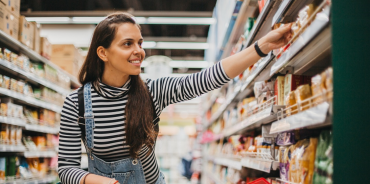Why hyper personalisation is the path to smarter advertising spend
I’d like to tell you a story.
A few weeks back, I went into my local store to do my weekly shop. One of the items on my list was milk, and when I got to the shelf I was shocked by what I found. The carton I’d paid just five dollars for the previous month was now $7.50, and as I stood there processing that, a fellow customer standing to my side confirmed what I was already thinking: “wow, this is so expensive”.
The two of us struck up a conversation and, by the time another person joined us, we were debating the idea of convincing our kids to drink less milk. But then, that third customer said something that I couldn’t have put better myself. “I’ll tell you what,” she began, “it isn’t just this store. Prices are going up everywhere. At least here they have discounts in the app – that’s why I keep coming back.”
As I smiled knowingly to myself, I realised just how right that lady was. Everywhere you turn at the moment, prices are high and people are struggling. Because of that, being able to give them discounts on the products that really matter to them is absolutely priceless from a loyalty perspective.
That, of course, requires some degree of investment from retailers and brands. And just as shoppers are being more cautious with their spending habits at the moment, grocery and consumer-packaged goods companies also need to be sure that they’re not investing in the wrong promotions, products, or customers right now.
Why, after all, invest in customers who will visit the store, pick up a single product that’s on promotion and then leave without buying anything else? Why not invest in those customers who will truly value the offers they’re sent? Those who’ll add more goods to their baskets as a result and, critically, come back? To do that effectively requires hyper personalization – targeted offers that appeal specifically to individual customers – at huge scale.
Personalization of this kind is abundantly possible, but it also comes with a number of potential pitfalls that are all too easy to fall into. With that in mind, I’d like to share seven of what I believe are the most common.
1. An over-reliance on traditional channels
Reactive digital marketing isn’t the uncharted territory that it once was. Nonetheless, grocery is an industry that is still heavily reliant on paper, with direct mail, leaflets, and coupons at the till serving as just a few examples. Important though they may be, if they’re standing in the way of greater personalisation through digital transformation, then that’s a problem.
Example: One EMEA retailer offered double points in its app and saw a 39% offer redemption rate.
2. Making assumptions about cannibalisation
There’s a tendency within grocery to assume that different propositions run within the same channel will ultimately end up cancelling each other out. The beauty of personalisation is that the opposite is true, with combined solutions actually serving to amplify one another while addressing multiple customer needs. Relevant promotions, personalised offers, and seasonal offers can all play well together!
Example: At one Latin American retailer, customers exposed to both Relevant Promotions and Personalised Offers had a higher spend per visit than customers exposed to just one.
3. Focusing solely on rewards or acquisition
Building on the above, it can also be tempting to believe that it’s only possible to deliver rewards or drive acquisition through hyper personalisation. Again, that’s not correct. Rewards deliver offers on products a customer already buys. Acquisition gives them an incentive to try something new. These two things nurture each other, helping shoppers feel appreciated and able to explore.
Example: A combination of rewards and acquisition-based activities across 38 different programmes saw higher sales uplift than either in isolation.
4. Complicating customers’ lives
When pursuing ‘better’ outcomes for themselves, retailers and brands can also make life more complex for their customers – particularly when trying to address internal issues or fears. Trying to push customers to buy earlier, or enforcing incremental sales, can ultimately undermine the value that personalisation delivers. Find the right customers, deliver the right offers, and the uplift will come.
Example: At one EMEA retailer, 8x the number of customers sent a single-buy offer redeemed it compared to those sent a multi-buy one.
5. Prioritising variety or choice over relevance
As marketers, it might bother us that offers are duplicated from campaign to campaign. We might also be tempted to think that customers are passionate about choosing their own offers. In test after test, however, the best performing offer campaigns are those that prioritise relevancy above all else. Variety and choice might “feel” good to us, but it’s relevance that customers truly value.
Example: When one EMEA retailer focused on variety over relevance, promotional participation rates fell by more than 50%.
6. Believing that personalisation demands a discount
In grocery retail specifically, there’s a tendency to assume that personalisation doesn’t work unless it comes with the offer of a discount. The reality is that treating customers as individuals and delivering relevant messaging wherever they are on their shopping journey pays dividends. Customer favourites, tailored recommendations, and relevant substitutions can all work without a price reduction.
Example: For one North American retailer, “Have you Forgotten” suggestions have driven a 65% conversion rate on full-priced products.
7. Second-guessing the science
Nothing will ever be as accurate as a science-based predictive model. Tempting though it can be to try and mimic it, or substitute it with business rules that have been effective before, it’s critical for retailers to sit back and let the science do its work. As is the case with relevancy, we’ve seen time and again that a science-based approach to targeting outperforms a rules-based one hands down.
Example: At one APAC retailer, science-based targeting improved sales uplift by 47% over the average of three rules-based campaigns.
As shoppers continue to focus on value, and as brands find themselves having to become more focused in their advertising investments, hyper personalisation holds many of the answers. Achieving it – and achieving it at the kind of scale at which grocery retailers operate, however – means trusting in the science and doing everything we can to remove these blockers to success.
TOPICS
RELATED PRODUCTS
The latest insights from our experts around the world
Navigating a shifting world: the headline results from our latest Consumer Pulse
Keeping it relevant and authentic: engaging consumers along the purchase journey



